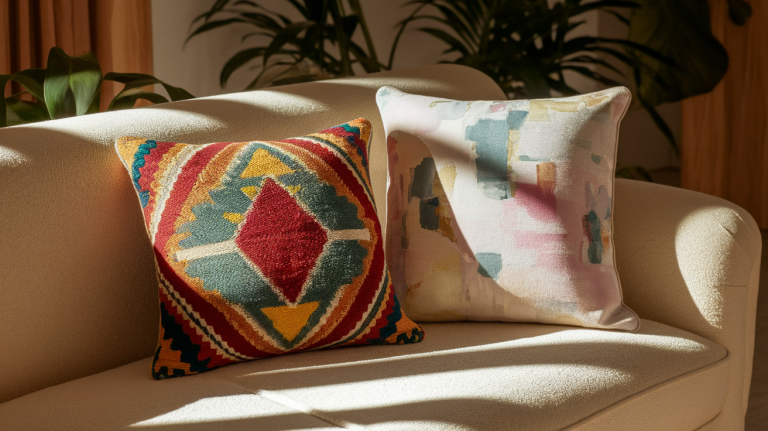Wood Stain Vs Paint: Which One Is Better?
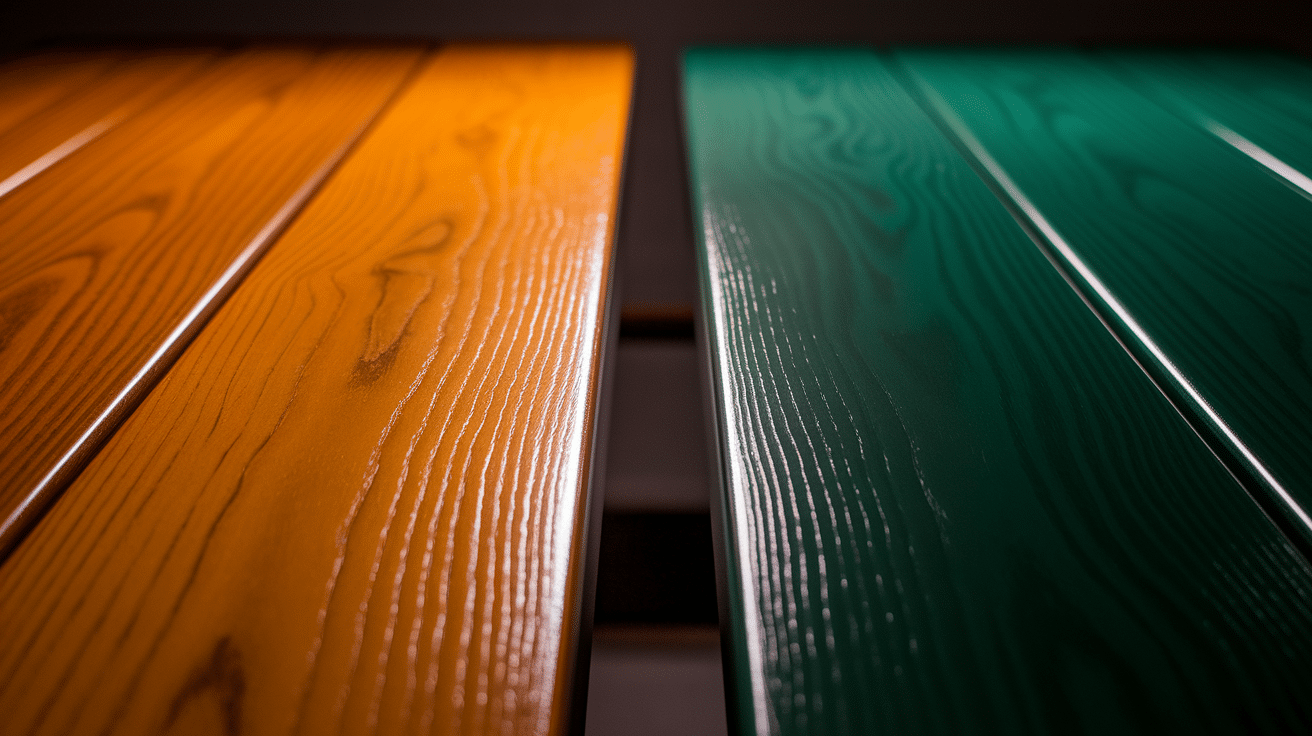
When updating wood around your home, one of the biggest questions people face is whether to choose wood stain or paint, because each option works very differently.
Stain soaks into the surface and highlights natural grain with warmth and depth, creating a rustic charm that shows off the wood’s character.
Paint, on the other hand, covers flaws with bold color, smooth coverage, and extra durability, which makes it a popular choice for heavy use or harsh weather.
We will be telling you about wood stain vs paint, their benefits, costs, applications, and how to pick the right finish.
Wood Stain vs Paint
Choosing between wood stain and paint depends on where and how the wood will be used.
Stain works well for decks or fences that should blend naturally into their surroundings, highlighting grain while aging gracefully.
Paint, on the other hand, is a stronger option for outdoor furniture or porches that face heavy use or harsh weather.
Climate also matters, since paint provides better protection in extreme conditions while stain performs best in moderate environments.
Wood Stain vs Paint: A Quick Comparison
Here’s a simple side-by-side breakdown of how wood stain and paint differ in appearance, durability, protection, and maintenance.
| Aspect | Wood Stain | Paint |
|---|---|---|
| Visual Appeal | Shows natural grain with rustic, organic finish. | Solid color hides grain for a sleek look. |
| Protection | Guards against moisture/UV but wears faster. | Strong shield against weather, sun, and damage. |
| Maintenance | Low upkeep, needs reapplication as it fades. | Higher upkeep, can chip or peel. |
| Durability | Works well in mild climates. | Very durable, best for harsh conditions. |
| Application | Easy, quick, little prep needed. | More prep, multiple coats, longer drying. |
| Best For | Decks, fences, and furniture where grain matters. | High-traffic/outdoor surfaces needing protection. |
| Climate Fit | Better in moderate weather. | Ideal for extreme sun, rain, or snow. |
Stain vs Paint for Indoor Projects: Which Works Best?
Both stain and paint offer unique advantages, and understanding these benefits will help you decide which finish best matches your project’s style and needs.
Why Choose Stain?
Wood stain is the right choice if you want to keep the natural charm of wood while still adding color and protection.
- Keeps Natural Beauty: Stain enhances the grain and texture, bringing out a rich, deeper tone that preserves the wood’s original character.
- Gives a Rustic Look: It creates a softer, organic finish that feels warm and inviting, perfect for a natural style.
- Protects Outdoors: Stain defends decks, fences, and furniture from UV rays, moisture, and weather damage while maintaining a natural appearance.
Why Choose Paint?
Paint is the best choice when you want a finish that not only protects wood but also changes its look with strong color and lasting durability.
- Covers Flaws: Paint is great for hiding scratches and dents on old wood and giving the surface a fresh look.
- Smooth Finish: It fills in small cracks and creates an even layer that looks polished and neat.
- Bold Colors: If you want bright or custom colors, paint gives you endless options to match your style or décor.
- New Look: Paint can quickly change the feel of a room or furniture piece from modern to classic.
- Good for Damaged Wood: If the wood is rough or the grain isn’t attractive, paint can hide it and make it look brand new.
Types of Wood Stain and Paint
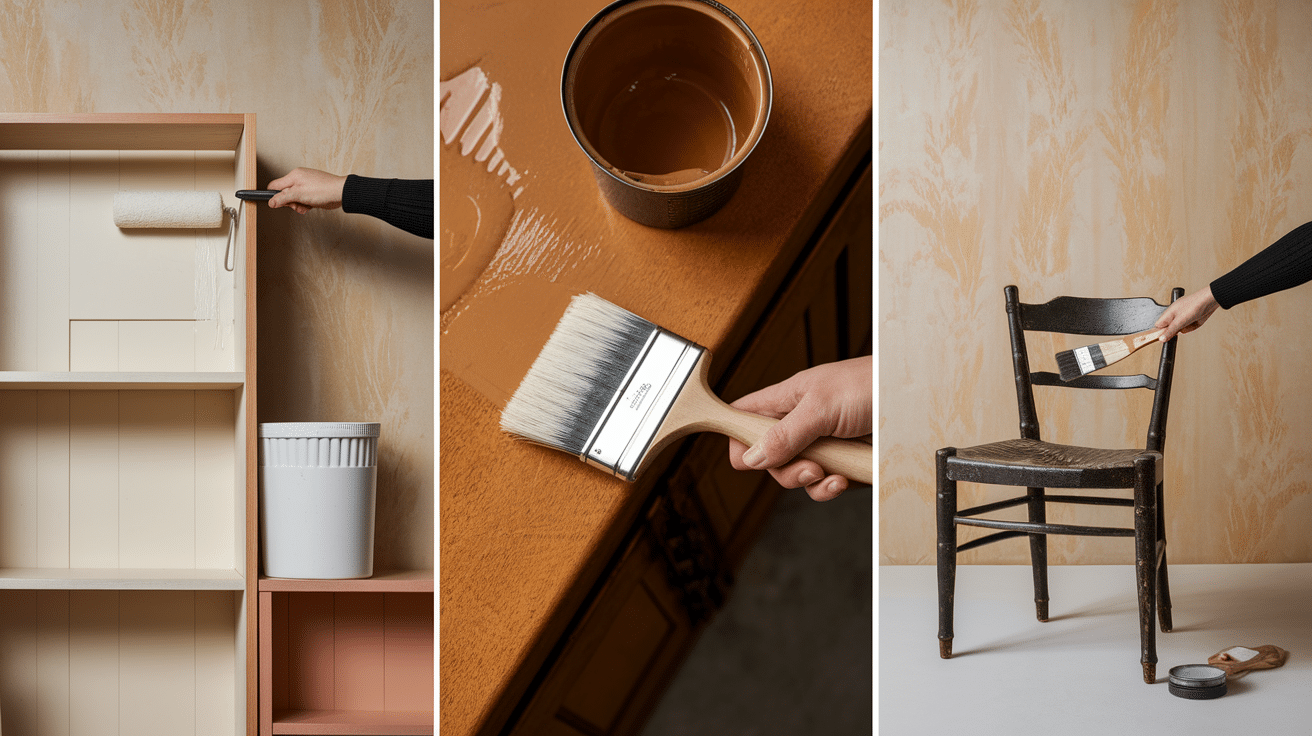
Before choosing the right finish, it helps to understand the main types of wood stain and paint, since each offers unique benefits for different projects.
Types of Wood Stain
Different types of wood stain bring out unique looks and levels of protection, so knowing the options helps you choose the right one for your project.
1. Oil-Based Stain: Oil-based stains penetrate deeply into the wood, providing a rich, vibrant color and durable finish. However, they have a strong odor, a longer drying time, and require mineral spirits for cleanup.
2. Water-Based Stain: Water-based stains dry quickly, offer an even finish, and are easy to clean with soap and water, making them ideal for beginners and indoor projects.
Paint Types for Wood
Paint for wood comes in several types, each offering a different finish, durability, and style, making it easier to match your project’s needs.
1. Latex Paint: This water-based paint is easy to use, dries quickly, and cleans up with soap and water. It has a mild smell and is great for indoor furniture, walls, and trim, making it perfect for busy homes.
2. Oil-Based Paint: Oil-based paint takes longer to dry but provides a tough, smooth finish. It’s ideal for high-traffic surfaces like cabinets and doors, offering resistance to chipping and moisture. Cleanup requires special solvents like mineral spirits.
3. Chalk Paint: Chalk paint gives a soft, matte finish, ideal for a vintage or farmhouse look. It requires little prep and is perfect for DIY furniture makeovers. You can distress it for an aged effect or seal it for extra protection.
How to Apply Stain and Paint? A Simple Step-by-Step Guide
Staining and painting both follow a few simple steps. Just take your time and treat the wood with care for great results.
How to Stain Wood?
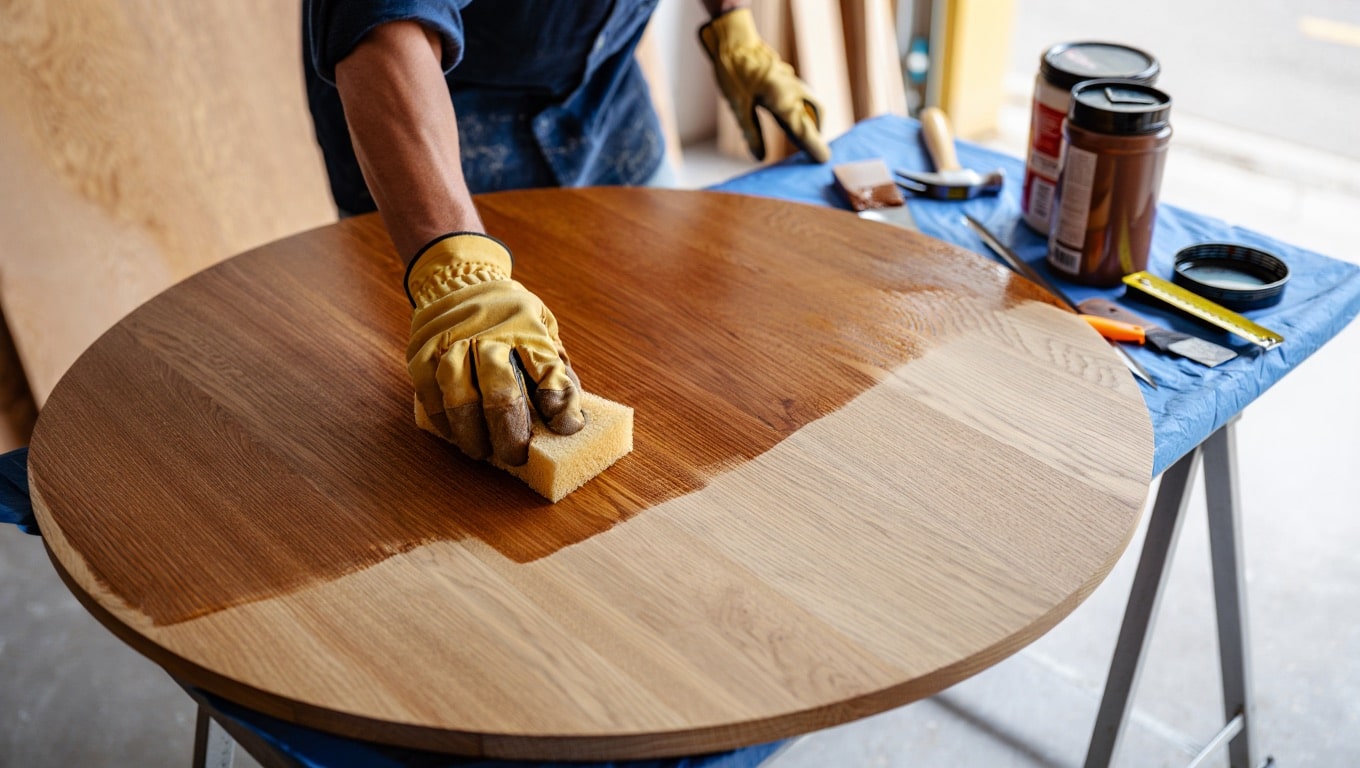
Staining wood is simple if you follow the right steps carefully, ensuring the finish looks smooth and lasts for a long time.
Step 1: Sand the Surface
Use medium to fine sandpaper to smooth the wood. This helps the stain soak in better and prevents uneven spots or rough textures.
Step 2: Clean the Dust
After sanding, wipe off all the dust with a tack cloth or a damp rag. A clean surface helps the stain apply evenly and stick well.
Step 3: Apply the Stain
Brush or wipe the stain onto the wood following the grain. Apply evenly and take your time to avoid streaks or blotchy patches.
Step 4: Wipe Off the Excess
After letting the stain sit for a few minutes, wipe off any extra with a clean cloth to get a clean and natural-looking finish.
Step 5: Let It Dry and Seal It
Let the stain dry completely, usually overnight. After drying, add a clear wood sealant to protect the color and make the finish last longer.
How to Paint Wood?
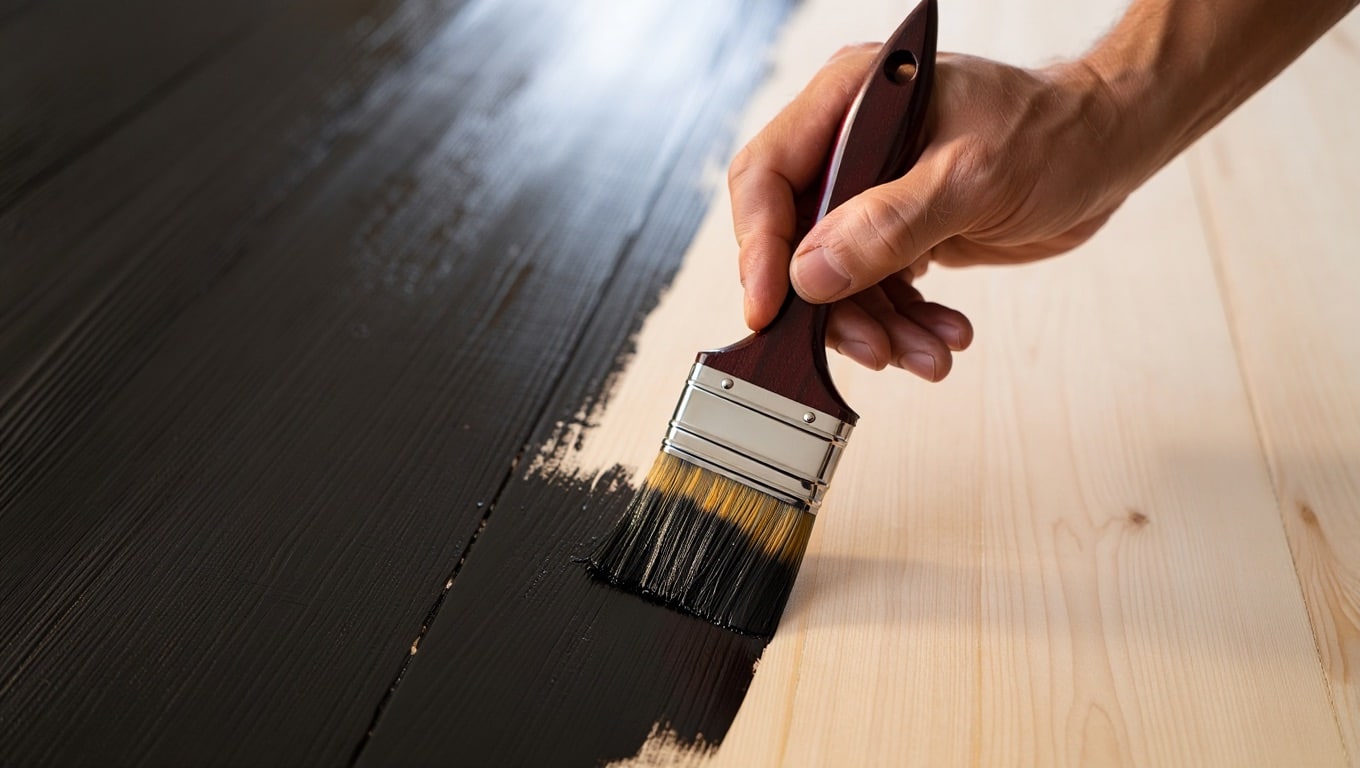
Painting wood takes a bit more preparation than staining, but the results give a smooth, durable finish that protects and completely changes the surface.
Step 1: Sand the Surface
Start by sanding the wood to remove rough areas or old paint. This gives the new paint a smooth, clean base to stick to.
Step 2: Clean the Surface
Use a soft cloth to remove sanding dust and dirt. Make sure the surface is dry before applying anything to avoid peeling later.
Step 3: Apply Primer
A coat of primer prepares the surface and covers dark spots. It also helps the paint go on evenly and stay vibrant over time.
Step 4: Paint in Thin Coats
Apply paint in thin, even layers using a brush or roller. Let each coat dry before adding another to avoid drips and uneven spots.
Step 5: Let It Dry and Protect
Allow the paint to dry fully. For extra durability, especially on furniture, finish with a clear topcoat to protect the surface from damage.
Stain vs Paint for Indoor and Outdoor Projects
When deciding between stain and paint, it’s important to consider the specific environment where the wood will be used.
Each finish serves different purposes, especially for indoor vs. outdoor projects.
Indoor Use: Stain vs. Paint

For indoor projects, consider the atmosphere and style you want to achieve.
Stain enhances the wood’s natural look, making it perfect for pieces like furniture and flooring.
Paint, on the other hand, offers a more solid, uniform finish that can cover imperfections and add vibrant color to trim or doors.
- Stain: Ideal for natural wood accents like furniture and cabinets. It preserves and highlights the grain, adding warmth.
- Paint: Best for surfaces that need a smooth, even finis,h like trim, doors, and walls. It also allows for bold, vibrant colors.
Outdoor Use: Stain vs. Paint
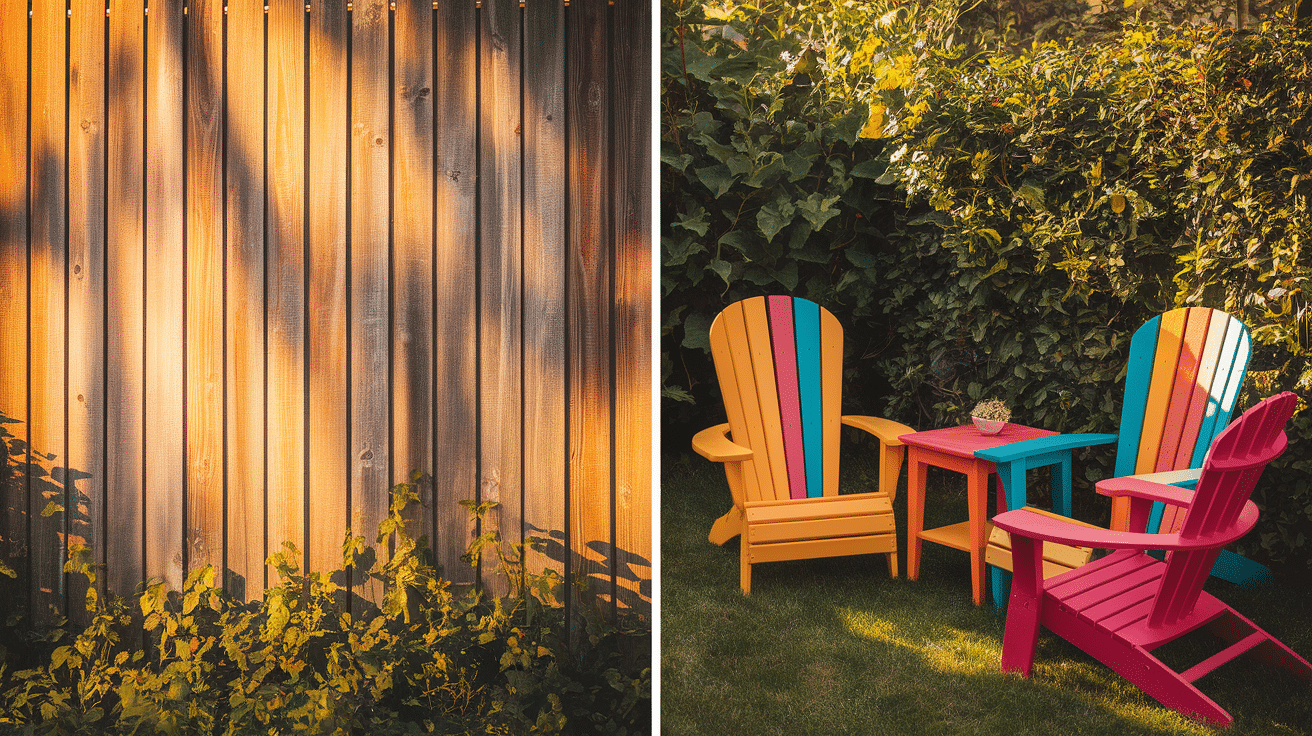
When it comes to outdoor use, both finishes offer protection, but with different strengths.
Stain works well on fences and decks, enhancing the wood’s texture while offering resistance to the weather.
Paint provides a durable barrier, making it the go-to choice for outdoor furniture or wood exposed to harsh elements.
- Stain: Works well on outdoor furniture, fences, and decks, offering a natural, rustic look while shielding from moisture and UV rays.
- Paint: Perfect for wood exposed to the elements, providing a tough, protective layer against rain, sun, and wear.
Understanding the Cost Difference Between Paint and Stain
When deciding between stain and paint, cost is always a factor to consider.
Both options come with their own set of expenses, from the price of materials to the tools and maintenance over time.
Let’s break it down so you can make an informed decision for your project.
| Item | Stain | Paint |
|---|---|---|
| Material Cost | $15 – $50 per gallon (typical oil-based: $30–$50/gal; some as low as $15–$20/gal) | $20 – $70 per gallon (average around $25/gal, premium up to $70) |
| Brushes/Applicators | $5 – $15 for quality brushes | $5 – $30 for quality brushes |
| Prep Materials | $5 – $20 for sanding & cleaning | $5 – $25 for cleaning & priming |
| Sealer/Topcoat | $10 – $40 for protective finish | $10 – $50 for protective finish |
| Long-term Maintenance | Lower cost, occasional reapplication | Higher cost, needs touch-ups more often |
| Time for Application | Quick and easy, less time-consuming | Takes more time, multiple coats needed |
Money-Saving Tips for DIYers
Here are some money-saving tips for DIYers for buying stain or paint for their projects:
- Buy in Bulk: If you’re tackling multiple projects, buying stain or paint in larger quantities can save you money in the long run.
- Use Affordable Tools: For basic DIY projects, you don’t need to buy high-end brushes. Mid-range tools will still get the job done effectively.
- Shop Smart: Look for sales and discounts at local hardware stores or online retailers. Prices can vary significantly depending on the brand and season.
- Skip the Sealer (If Possible): If your project is indoors and won’t be exposed to moisture, you might not need a topcoat or sealer, saving on additional costs.
Choosing Between Wood Stain and Paint
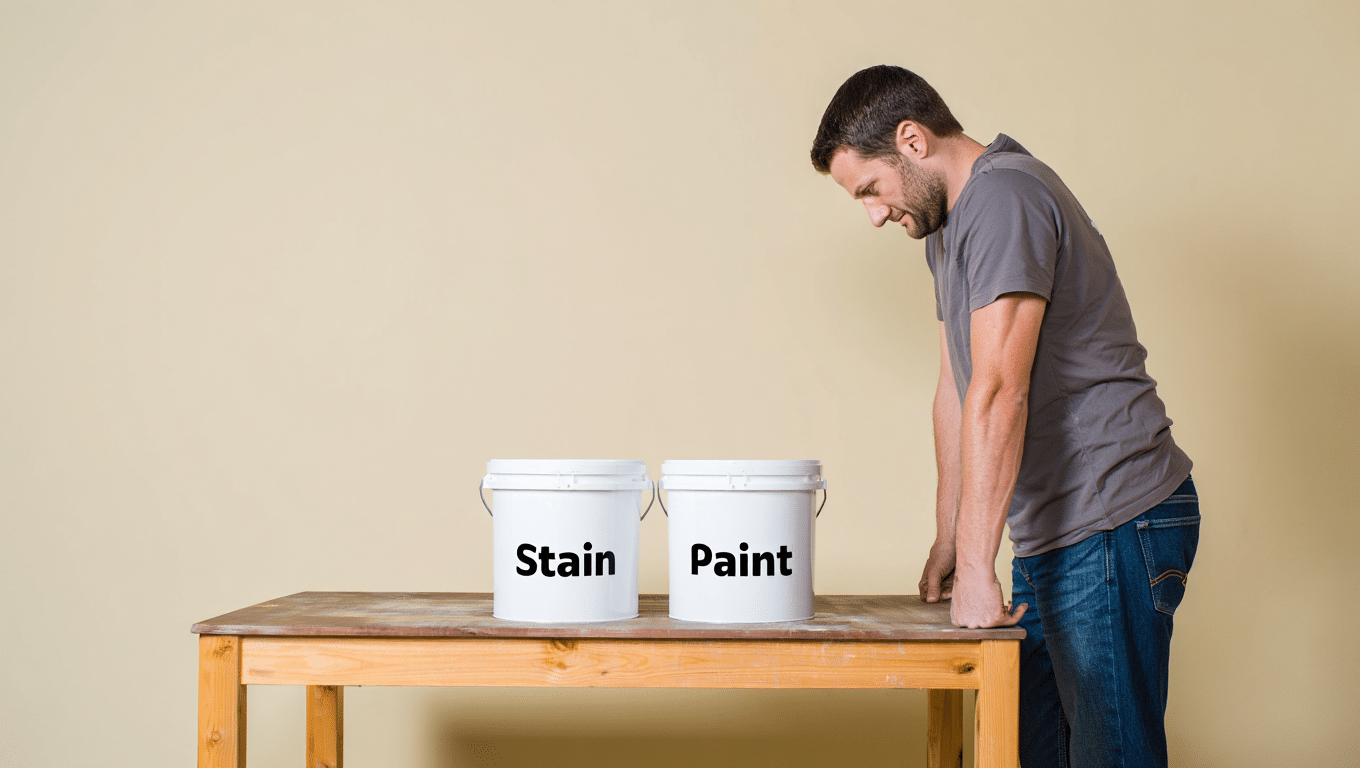
Picking between wood stain and paint can feel confusing, but it becomes easier once you think about the look you want, the upkeep you can handle, and where the wood will be used.
1. What’s the Look You Want?
Stain highlights the natural grain and texture of wood, giving it a rustic and warm character that feels organic and timeless.
Paint covers the surface fully with solid color, creating a polished and uniform appearance.
If you love the natural beauty of wood, stain is the best choice, but for bold colors and a sleek modern style, paint works better.
2. How Much Maintenance Are You Ready for?
Stain fades slowly and does not peel, which makes reapplication simple and less demanding over time.
Paint can chip or peel in areas with heavy use or harsh weather, which means it requires more frequent maintenance.
If you prefer a low-maintenance finish that naturally weathers, stain is ideal. If you want long-lasting, strong color and are fine with upkeep, paint is the better choice.
3. What’s the Environment Like?
Stain absorbs into wood and works well in mild climates, offering decent protection against sunlight and moisture.
Paint forms a thicker barrier that holds up better against tough conditions like snow, rain, and strong sunlight.
If your wood is in a harsh environment, paint is usually the safer option.
For moderate climates, stain provides a durable finish while keeping the wood’s natural appearance visible.
4. How Much Prep Time Do You Have?
Stain requires little preparation, applies easily, and dries quickly, so you can finish the project in less time.
Paint involves more steps, including sanding, priming, and applying multiple coats, which takes more effort and time to complete.
If you want a quick project, stain is the better option, but if you want a stronger and longer-lasting finish, paint is worth the additional preparation.
Questions to Ask Yourself Before Choosing
Before finalizing your choice, ask yourself these questions to make the decision clear:
- “Do I want the wood’s natural grain and texture to show?”
- “How much weather exposure will the wood face?”
- “Am I okay with some maintenance and touch-ups?”
- “How much time do I have for preparation and application?”
By answering these questions, you’ll be able to choose between wood stain and paint that fits your style, maintenance preferences, and the specific needs of your project.
The Bottom Line
In the end, choosing between wood stain and paint depends on what matters most for your project, whether that is showing natural grain or adding solid color.
Stain brings out the character of wood with warmth and charm, while paint protects surfaces with strength and vibrant appeal that lasts through wear and weather.
The right choice should match your space, your style, and the level of care you are ready to give for a long-lasting finish.
Do you prefer the rustic look of stain or the bold strength of paint for your wood projects? Tell us, share with us in the comments below.

